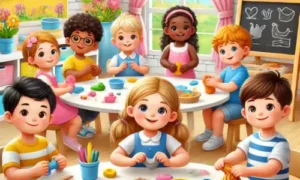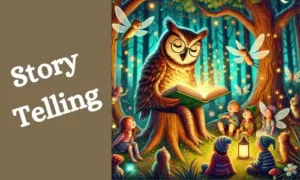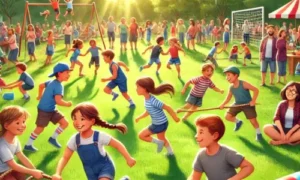Recently updated on December 5th, 2024 at 08:28 am
Basic teaching exercises for young children should be interactive, hands-on, and suitable for their developmental stage. Here are a few illustrations.
1. Sensory Play:
Use objects like water, sand, playdough, grains, or beans to create opportunities for sensory exploration. By using these materials to scoop, pour, mould, and manipulate, children can develop their fine motor skills and senses.

A basic sensory play activity for nursery students could be a “Sensory Bin Exploration.” Here’s how you can set it up:
Materials Needed:
- Large plastic bin or container
- Sensory materials (e.g., rice, dried beans, sand, shredded paper)
- Small toys or objects for hiding and discovering (e.g., plastic animals, scoops, cups)
- Optional: Funnels, measuring spoons, small containers for pouring and scooping
Instructions:
1. Select a range of kid-safe and developmentally appropriate sensory materials for the kids. To create a varied sensory experience, take into consideration utilizing materials with various textures, colours, and shapes.
2. Place a few of the chosen sensory objects inside the plastic bin or container. Depending on the container size and quantity of material available, you can fill it up to halfway or even beyond.
Use the sensory material to conceal the little toys or objects. Let kids find them by hiding them slightly below the surface or sprinkling them all over the cloth.
3. Situate the sensory bin where kids can readily get to it, like a large table covered in a cloth or mat for play areas or a designated play area.
4. Put the sensory bin wherever kids can readily get to it, like a big table covered in a cloth or mat for play areas or a designated play area.
5. Allow the kids to freely explore the sensory bin. Urge them to handle the materials with their hands—to scoop, pour, sift, etc. Describe the textures, colours, and sensations they encounter to promote sensory inquiry.
6. Make use of the tiny toys or items in the sensory bin to promote imaginative play. Kids can imagine that the toys are exploring a terrain or habitat made of the sensory material.
7. Keep a close eye on the action to guarantee safety and offer support when required. Keep an eye out for any little objects that could choke someone and take them out right once.
8. Encourage kids to assist with cleanup by returning the sensory material to its original container after the activity. Talking about their top findings and insights from the exercise is another way to enhance the learning process.
2. Art & Craft:
Provide an assortment of art supplies like glue, paint, markers, crayons, and collage materials. Children should be encouraged to participate in unstructured art projects that allow them to freely express themselves by sticking, painting, cutting, and drawing.

A basic art and craft activity for nursery students could be “Fingerprint Art.” Here’s how you can set it up:
Materials Needed:
- Washable non-toxic finger paints in various colors
- White paper or cardstock
- Markers or pens (optional)
- Baby wipes or damp cloths for easy cleanup
- Optional: Stickers, googly eyes, glitter glue, or other embellishments
Instructions:
1. Prepare a space set out for art and cover it with a mat or protective covering to catch spills and debris.
2. Arrange the cardstock or white paper on the desk or table.
3. Use tiny amounts of finger paint, one colour per tray, to coat shallow trays or plates. Make sure there’s enough room between each colour so kids may dip their fingers in them without getting too much paint mixed in.
4. Encourage the kids to experiment with the finger paints by dipping them into the paint trays and using them to create prints on the paper. Motivate them to try out various hues, designs, and approaches.
5. Promote creativity by offering them several ideas for using their fingerprints, including making flowers, animals, or abstract patterns.
6. Give them pens or markers so they can add features or decorations to their fingerprint paintings, including faces, stems, or other designs.
7. If you would like, provide them with stickers, googly eyes, glitter glue, or other accessories to add even more flair to their artwork.
8. After completing the exercise, encourage kids to wash their hands with moist cloths or baby wipes.
9. Send the finished fingerprint art home with the kids so they can show it to their family or hang it up in the classroom.
3. Story Time:
Use age-appropriate books with vivid illustrations and straightforward narratives to read aloud to the kids. Promote involvement through posing queries, formulating guesses, and engaging in dialogue about the characters and storyline.

A basic activity with Story Time for nursery students can involve interactive storytelling and engaging discussions related to the story. Here’s a simple example:
Activity: Story Retelling and Character Exploration
Materials Needed:
- Age-appropriate storybook with colourful illustrations and a simple storyline
- Large picture cards of the main characters or key objects from the story (optional)
- Story-related props or costumes (optional)
- Open space for group seating or circle time
Instructions:
1. Select a picture book with simple language and captivating graphics that is appropriate for young readers.
2. Gather the kids in a semicircle of chairs or a circle on the floor to create a comfortable seating configuration.
3. Show the kids the book’s cover to introduce the tale, and have a conversation with them about the title and images. Encourage them to use the cover to infer possible plot points for the novel.
4. Use expressive voices and movements to bring the characters and events to life as you read the narrative aloud to the kids. Ask questions and promote involvement by pausing periodically.
5. Discuss with the kids about the characters, setting, and storyline after you’ve read the story to them. To promote comprehension and critical thinking, pose open-ended questions like “Who were the main characters in the story?” to your audience.
“What happened at the beginning/middle/end of the story?”
“How did the characters feel at different parts of the story?”
“What was your favourite part of the story?”
6. Use huge picture cards or props to assist kids in recognizing and recounting the story’s essential details. Encourage them to describe the events of the story in turns while holding the cards.
7. Promote imaginative play by giving kids clothes or props from the story so they can act out certain scenarios. Permit them to perform their preferred roles and investigate the characters’ perspectives.
8. Include related activities to extend the learning process, including tale-inspired art projects, dramatic play scenarios, or activities that require you to recount the story in order.
9. Summarize the tale and talk about the lessons or concepts it teaches to wrap up the exercise. Invite kids to talk about their ideas and interpretations of the tale.
4. Outdoor Play:
Make use of outdoor play to promote physical activity and the development of gross motor skills. Create a playground featuring swings, slides, climbing frames, and balance beams. Let kids run, jump, climb, and investigate their surroundings.

A simple outdoor play exercise for young children is the “Nature Scavenger Hunt.” This is how to set it up:
Materials Needed:
1. Inventory of goods to be found in nature (such as leaves, rocks, flowers, sticks, and feathers) 2. Optional small baskets or bags for gathering items
3. Optional magnifying glasses or binoculars
4. For older kids, clipboards and pencils (optional)
5. If playing close to a road, safety jackets or reflective clothing are optional.
Instructions:
1. Select a secure outdoor area, like a playground, schoolyard, or neighbouring park, for the scavenger hunt. Make sure the space is safe for small children and devoid of risks.
2. Make a list of objects found in nature that kids can find during the scavenger hunt. Add a range of objects, including varied-sized and shaped leaves, different coloured flowers, sticks of varying lengths, and feathers, if any are available.
3. Call the kids together and go over the scavenger hunt’s guidelines. Urge them to locate the items on the list by working alone or in small groups.
4. If wanted, distribute bags or baskets for gathering the natural objects. As an alternative, kids can gather objects with their hands or on
a large piece of fabric.
5. Start the scavenger hunt and let the kids roam throughout the outdoor space while they look for the things on the list. Urge children to examine plants, trees, and other natural features closely using their observational skills.
6. Give kids who want to look more closely at objects binoculars or magnifying glasses. Urge children to search for details in rocks and flowers, insects, or patterns on leaves.
7. Encourage kids to share what they learn with the group as they locate each item on the list. As you invite them to explain the objects they discovered, provide questions to start a conversation.
8. After the children have finished the scavenger hunt or when all the things on the list have been located, get them together to discuss what they have discovered. Talk about the many objects they discovered and invite them to share any noteworthy findings or observations.
9. Express gratitude to the kids for taking part in the treasure hunt and urge them to keep discovering and enjoying nature.
5. Music and Movement:
Use music and movement exercises to help with self-expression, rhythm, and coordination. Sing and dance, play musical instruments, and take part in easy movement activities like musical chairs or Simon Says.

For young children, a “Free Dance Party” is a fundamental music and movement activity. This is how you put it together:
Materials Needed:
1. Speaker or music player
2. A variety of age-appropriate tracks in various tempos and genres (children’s songs, classical music, lively tunes, etc.)
3. A clear place in the playground or classroom might be used as a dancing zone.
Instructions:
1. Make sure there is room for kids to walk about freely and unhindered in the classroom or outside.
2. Prepare a playlist of songs with different tempos and styles and set up the music player or speaker. To accommodate a range of tastes and activity levels, use well-known children’s songs, classical music, and lively tunes.
3. Call the kids together and inform them that a free dance party is about to begin. Encourage them to move their bodies any way they like while they listen to the music.
4. Turn on the music and encourage the kids to dance and explore the room. Urge them to express themselves via movement and to use their imaginations.
5. Give them ideas of various exercises they can attempt, such as leaping, spinning, hopping, marching, or stretching. Urge them to mimic the beat and tone of the music by moving their body in various ways.
6. Take part in the dance yourself to promote participation and show off various moves. Encourage kids of all skill levels to participate in the activity and go at their own pace to make it inclusive.
7. Encourage kids to socialize with one another by forming their dance routines, dancing together, or mimicking one another’s moves throughout the dance party.
8. now and then ask the kids to freeze still while the music is paused. Take advantage of this chance to see how they move, acknowledge their efforts, and provide encouraging remarks.
9. Put the music back on and carry on the dance party for as long as the kids are excited and involved.
10. To wrap up the activity, indicate that the dancing party is coming to an end by progressively lowering the music. Bring the kids together and express gratitude for their involvement. Urge them to pause, take a deep breath, and do some light stretching or breathing techniques to help them cool down.
Conclusion:
In this sensory play exercise, children may increase their imagination and creativity while also activating their senses, which helps them enhance their fine motor skills.
With this painting and craft project, children may express themselves creatively while also developing fine motor skills, creativity, and sensory exploration. It’s simple, fascinating, and easily adaptable to other themes or events. This interactive Story Time activity promotes language development, comprehension skills, and social-emotional learning through engaging storylines and thought-provoking dialogues.
This outdoor play exercise promotes curiosity, attention to detail, and appreciation for nature. It engages children’s senses and encourages their inherent curiosity about the world around them. This musical and dance practice promotes self-expression, coordination, creativity, and physical exertion.







Registrera dig
September 4, 2024Thank you for your sharing. I am worried that I lack creative ideas. It is your article that makes me full of hope. Thank you. But, I have a question, can you help me?
live slot365
September 4, 2024Nhà Cái nổ hũ 66b sở hữu số lượng thành viên tham gia siêu khủng bởi hệ thống vận hành chuyên nghiệp, mang lại cơ hội khám phá sản phẩm đặc sắc đa dạng trên thị trường. Thương hiệu cung cấp các sảnh cược nổi tiếng như: Bắn Cá, Casino Trực Tuyến, Thể Thao, Đá Gà, Nổ Hũ
tải xn88
September 4, 2024Bạn có thể chơi lô đánh đề từ 1.000+ kỳ quay thưởng đang diễn ra liên tục và hốt tiền cực nhanh chỉ sau 1 giây. mã nhận thưởng 888slot cung cấp nhiều kiểu cược xổ số khác nhau như: Bao lô, đánh đề, 3D, lô trượt, 4 càng giải Nhất,… đặc biệt là Up/Down, Reverse, Big/Small,… vừa mới “ra lò”.
888slot con
September 4, 2024tải 188v Để giúp bạn dễ dàng tiếp cận và trải nghiệm các dịch vụ cá cược mọi lúc, mọi nơi, nhà cái đã phát triển ứng dụng di động tiện lợi. Ứng dụng này tương thích với cả hai hệ điều hành Android và iOS, mang lại sự thuận tiện tối đa cho người dùng. Dưới đây là hướng dẫn chi tiết cách tải và cài đặt app trên điện thoại di động của bạn.
binance-
September 4, 2024Can you be more specific about the content of your article? After reading it, I still have some doubts. Hope you can help me. https://www.binance.com/es/register?ref=RQUR4BEO
kuhni-v-ivanovo.ru
September 4, 2024Официальные награды имеют особое значение в жизни общества.
Они отмечают заслуги людей, которые проявили себя в развитие страны.
Такие награды помогают формировать положительный образ общественной деятельности.
Также, они мотивируют людей на дальнейшие успехи.
изготовление призов
Официальное признание нередко усиливает доверие к человеку в обществе.
Следует учитывать, что награда — это не просто знак, а форма признательности.
Она поднимает ценность работы, который был совершён лауреатом.
В итоге, государственные награды остаются значимой частью традиций в государственной системе.
888slot trang chủ
September 4, 2024188v game Một ưu điểm hoàn hảo tại nổ hũ Fun 88 đó chính là giao diện vô cùng bắt mắt, đẳng cấp cùng luật chơi rõ ràng. Một số sản phẩm siêu hút chân cộng đồng cược thủ có thể kể đến như ăn khế trả vàng, kho kháu tứ linh, ngọn lửa chibi, long quy chi bảo,…
NathanKef
September 4, 2024На этом сайте представлено множество полезных материалов.
Пользователи отмечают, что ресурс удобен для поиска информации.
Информация поддерживается в актуальном состоянии, что делает сайт удобным для использования.
Многие считают, что навигация ресурса хорошо продумана и позволяет сэкономить время.
Большое разнообразие тем делает ресурс интересным для широкой аудитории.
Также отмечается, что материалы подготовлены качественно и понятны даже новичкам.
Сайт помогает получать новые сведения благодаря подробным статьям.
В целом, этот ресурс можно назвать надёжным источником информации для каждого посетителя.
https://dpnews.ru
NathanKef
September 4, 2024Здесь представлено много ценной информации.
Пользователи отмечают, что ресурс удобен для поиска информации.
Материалы обновляются регулярно, что делает сайт удобным для использования.
Многие считают, что навигация ресурса очень понятна и позволяет сэкономить время.
Разнообразный контент делает ресурс универсальным для широкой аудитории.
Также отмечается, что материалы подготовлены качественно и легко воспринимаются.
Сайт помогает получать новые сведения благодаря детальным обзорам.
Таким образом, этот ресурс можно назвать удобным местом для изучения важных тем для любой аудитории.
https://koreavto.ru
binance Kayit Ol
September 4, 2024Thank you for your sharing. I am worried that I lack creative ideas. It is your article that makes me full of hope. Thank you. But, I have a question, can you help me?
NathanKef
September 4, 2024На этом сайте представлено множество полезных материалов.
Пользователи отмечают, что ресурс облегчает доступ к важным данным.
Информация поддерживается в актуальном состоянии, что делает сайт практичным для изучения.
Многие считают, что структура сайта хорошо продумана и позволяет сэкономить время.
Большое разнообразие тем делает ресурс универсальным для людей с разными интересами.
Также отмечается, что материалы оформлены аккуратно и понятны даже новичкам.
Сайт помогает получать новые сведения благодаря детальным обзорам.
В целом, этот ресурс можно назвать удобным местом для изучения важных тем для каждого посетителя.
https://podzakazavto.ru
注册获取100 USDT
September 4, 2024Thank you for your sharing. I am worried that I lack creative ideas. It is your article that makes me full of hope. Thank you. But, I have a question, can you help me?
production company
September 4, 2024need a video? film production company in italy offering full-cycle services: concept, scripting, filming, editing and post-production. Commercials, corporate videos, social media content and branded storytelling. Professional crew, modern equipment and a creative approach tailored to your goals.